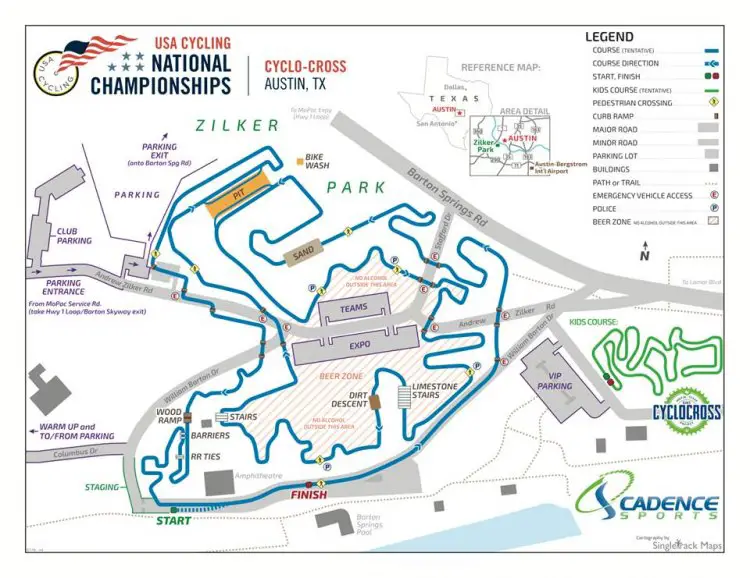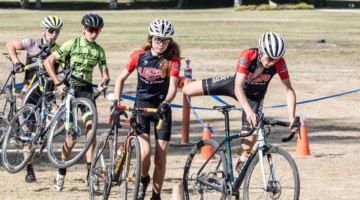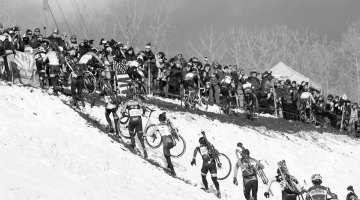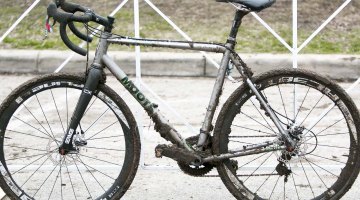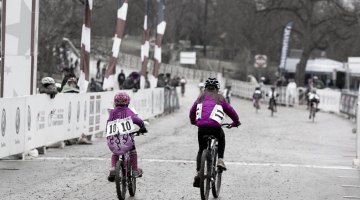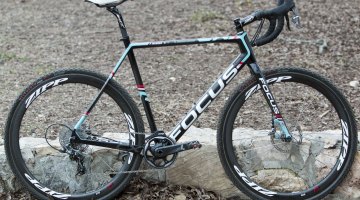While speaking with famed course designer Pete Webber, Carmichael Training Systems Coach Josh Whitmore examined the features and nuances of Zilker Park, host site of the 2015 Cyclocross National Championship. While there will always be beneficial mainstays of training for cyclocross, including group Wednesday Night Worlds practice, as well as threshold and VO2 Max intervals, riders looking for an extra edge can tailor a training plan that matches the conditions they will face come the second week in January.
Whitmore reached out to us with a few ideas of his own, including two interval sessions that can be done outdoors (one can also be done on a basement trainer, just remember not to use the brakes while on the rollers!) For more training plans and methods for surviving the winter, including recommended water uptake during training in the cold months, be sure to check out Carmichael Training Systems at trainright.com.
by Josh Whitmore
By this time of year, regional cyclocross races are winding down and many of you have season ending goals to peak for the Cyclocross National Championships January 7-11th, hosted this year at Zilker Park in Austin, TX. The few-week lull in racing over the holidays offers a great opportunity to get in some focused fine tuning for your fitness before the big event. The following course information and sample workouts will help you arrive with an edge over your competitors.
The specific physiological demands of cyclocross vary slightly from course to course. We caught up with Pete Webber (co-course designer with Keegan Schelling) to get a handle on what the course in Austin will be like in order to best prepare for what racers will actually face. Webber predicts, “in general, this is an all-rounder course, not heavily favoring one type of rider, [but] it will be hard and physical.”
Here are the major course characteristics:
Surface Conditions
The course at Zilker Park will be a lot of grass, but it is sparse, thin grass, not thick and plush. The sub-surface is predominantly a limestone substrate, which will offer a firm hardpack and fast rolling conditions. Even with a lot of rain, the course is unlikely to be muddy. Prepare yourself for a fine gravel surface in places and some loose rocks along with some bigger embedded rocks as well.
Short Steep Hills and Sharp Accelerations
One of the main characteristics of the course will be short, steep hills, often with a speed-robbing turn right at the bottom. These 20-30 yard sections will require a sharp acceleration from low speed at the bottom with maximum power output for 10 seconds to get to the top. Webber also characterized the course as “turny” overall, so expect big fluctuations in speed from fast rolling straights, to lower speed turns. Keep in mind that each turn will require a hard acceleration to get back to the higher-than-normal cruising speed on the straights.
Limestone Steps
The course will also feature two sets of limestone stairs, one longer than the other. These are natural steps in the local limestone layers, so they will not be evenly spaced like some typical park steps. Footing will be a bit tricky and you’ll have to pay close attention to the placement of each foot. The sets of limestone steps are fairly close to one another on the course with the longer of the two last in order. With a couple steep hills between the sets of steps, this will likely be a very tough, physically demanding section.
Training Specificity
With these course characteristics in mind, the next step is to evaluate your strengths and figure out which course component is most alien to you. How comfortable are you running up longer flights of steps? In your region, do you spend most of your race time slogging through thick mud as opposed to the more quick accelerations to high speed that will be necessary in Austin? How good are you at high-torque accelerations up steep hills from low speed? While fine-tuning your fitness over the next few weeks, modify your workouts to prioritize anticipated weak areas.
Sample workouts:
20/20sec Speed Intervals – Flats and stairs
For this workout, you’ll need to find a set of steps or a steep embankment that will take approximately 20secs to run up. You will also need to easily be able to ride back to the bottom. The pattern of this workout is to alternate between 20seconds “on” and 20seconds “off” for the duration of the set. Each “on” section will alternate between riding on flat ground and doing the dismount/run-up. Intermediate riders can do 2-3sets of 6min each. Advanced riders can do 2-3sets of 8-10min. Heart Rate and Power are not important to monitor during this workout, just go HARD. If you can record the information for analysis after the workout, that would be helpful.
Each set consists of the following:
20 seconds “on” Flat: On a flat section of grass or gravel, start from near dead stop, stand up and accelerate as hard as you can for 8-10sec. Then, sit and maintain that high speed with a cadence of 100-110 at a hard pace for the remainder of the 20sec.
20 seconds “off” spin lightly, recover.
20 seconds “on” run: Dismount and sprint up the steps / hill for 20 sec. Concentrate on short steps, high turnover rate, and placement of each foot.
20 seconds “off” spin lightly, recover, ride back to bottom of steps.
Repeat for duration of set
Rest between sets 8-10mins
Steady State Intervals with 10sec acceleration on the 1min
The goal of this workout is to develop your ability to execute and recover from hard accelerations while going at race pace. These are best done on a flat road surface, paved or gravel. Steady State intensity is 86-90% of your CTS Field Test power or 92-94% of Field Test heart rate, or an RPE of 8/10. Intermediate riders can do 2-3 intervals of 6-8min. Advanced riders can do 2-3sets of 8-10min. These are a little different than normal SS intervals, though, because there’s braking and then and acceleration on the minute. Using the timer on your computer, hit the brakes at :45 and then accelerate from about 5mph so you end your acceleration at 1:00. Ride at SS intensity until 1:45, slow down, then accelerate to 2:00, and so on.
Each interval consists of the following:
45 seconds in steady state zone
5 seconds, hit the brakes and slow to around 5mph
10 seconds, stand up and sprint
Sit down and maintain SS intensity for 45 seconds
Hit the brakes and slow to around 5mph over about 5 seconds
Stand up and sprint to the minute
Repeat the pattern, slow down to 5mph and do 10sec sprint every minute for the duration of the interval
Rest between intervals is equal to the interval length













